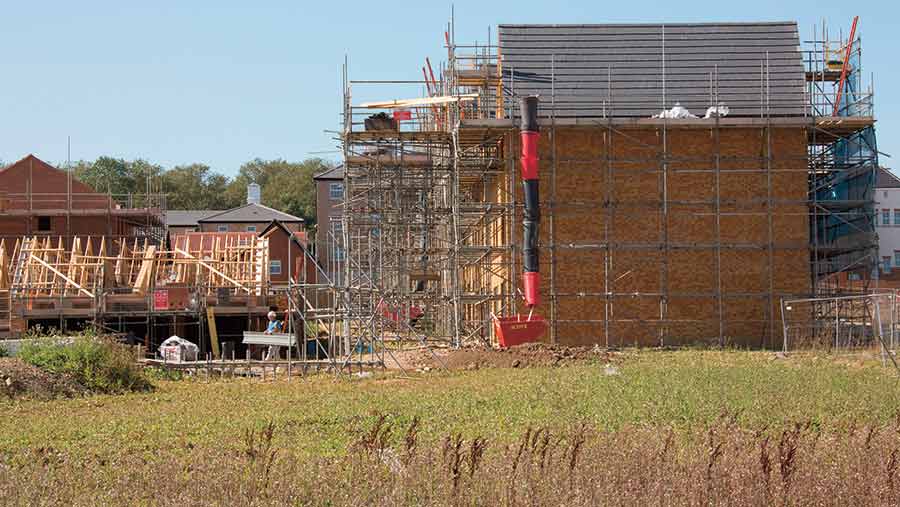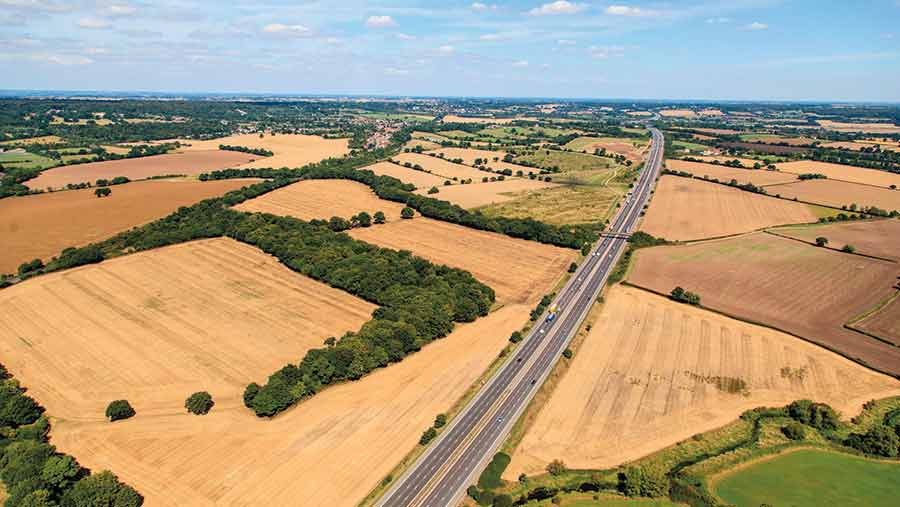Changes to compulsory purchase and what it means for farming
A government drive to progress infrastructure developments has prompted a rash of construction projects and significant changes to compulsory purchase legislation.
As well as the £42.6bn HS2 rail link, the government has committed £15bn to major road construction and improvement projects by 2020.
There are also more localised projects such as two multibillion-pound power supply projects in Kent and Lincolnshire, which have already taken swathes of farm land.
See also: Compulsory purchase: How landowners can protect their rights
Thousands of farmers are now caught up in the legalities of compulsory purchase as a result, says NFU rural surveyor Louise Staples.
“In a bid to avoid the legal wrangles that have dogged construction projects in the past, the government announced a series of measures in 2015 to make the compulsory purchase process ‘clearer, faster and fairer’,” she says.
The outworking of those aims can be seen in a number of Bills and Acts that have come to the fore in the past year – the Housing and Planning Act 2016, Neighbourhood Planning Bill and the High Speed Rail Bill.
Each of these contains legislation that will affect the lives and businesses of farmers on the receiving end of a compulsory purchase order. Here are the latest updates:
High Speed Rail Bill

© Ben Cawthra/Rex Shutterstock
Because the construction project is so large, the high-speed rail link between London and Birmingham (HS2) gets an entire Bill to itself. The proposed legislation is still in the House of Lords and has faced a large number of petitions against it.
Both the NFU and CLA have expressed huge concern at the lack of communication from High Speed Two – the company handling the project – to landowners.
See also: Business Clinic: Danger of undocumented family loans
In 2015, the planning minister was compelled to write to the company and local authorities along the route urging them to take a more positive and understanding approach when dealing with land acquisition.
Farmers have suffered six years of uncertainty, which has been hugely unsettling, says CLA chief surveyor Andrew Shirley.
“Farms are stagnating up and down the entire route. Instruments like the punitive interest rate will help to put pressure on the company, but it still has a huge amount of free rein.
“Farmers have already given voluntary access for many surveys and are still waiting months for compensation,” he adds.
One of the powers granted under the Bill allows High Speed Two to compulsorily purchase land anywhere. That means not just along the immediate route. It could be miles from the railway line.
For example, it may decide to purchase a greenfield site for a park-and-ride facility to ease traffic at a station.
Wildlife habitat areas required to offset the damage caused by the railway line are also contentious.
With HS2 there are some large blocks up 100 acres or more of woodland or grassland habitat, Mr Shirley explains.
The contention arises because there has been little or no discussion about where the habitat is sited, how it will be established or managed in the future. The land is earmarked for purchase without communication with the landowner.
“It is short-sighted to say the least, because there could be a better position to site the habitat that would better suit both parties,” Mr Shirley said.
Housing and Planning Act

© Tim Scrivener/Rex/Shutterstock
The Act sets out the major reforms of compulsory purchase and received Royal Assent in May.
Advance payments
Under the previous arrangements, acquiring authorities were required to make advance payments of 90% of the initial property value estimate, explains Ms Staples.
This should have been paid within three months of receiving a formal request or by the date of possession.
“But for many farmers the wait was often far longer. And in some cases farmers waited for 10 years to receive the final 10% of compensation due to them.
“The overdue payments did not incur interest payments, so there was no incentive whatsoever to pay up,” she said.
Businesses were being forced to relocate long before they were compensated.
“It put these farms under severe pressure, because in many cases it was difficult to obtain funding to pay for new property,” Ms Staples said.
To speed up this process, the Housing and Planning Act enforces new time limits. The earliest date by which a payment will be due will change from the point of entry to the date a notice of entry is served.
Interest on late compensation payments
Perhaps more significantly, the Act sets out the introduction of financial penalties on delayed payments to force acquirers to pay more quickly.
CLA chief surveyor Andrew Shirley says anyone withholding compensation payments will now face punitive interest rates.
The government has pledged to introduce a statutory instrument forcing acquirers to pay interest rates of 8% above base rate on the initial 90% of the advance payments. The remainder will face interest rates of 2% above the base rate.
“This is yet to be implemented, but the government has indicated some time at the beginning of 2017,” says Mr Shirley.
Rights of entry
“To end drawn-out negotiations between landowners and construction officials, the Act provides new rights of entry to land acquirers that want access to sites for surveys and other preparatory work,” adds Mr Shirley.
The Act has superseded the requirement for an acquiring authority to agree access with the landowner where they do not have the statutory power to enter.
Instead the acquiring bodies have been granted extended powers, which means there is no longer a need to reach agreement.
The bodies now issue a 14-day notice to landowners giving them the right to carry out preparatory work. The owner has no right to resist and warrants can be issued by local magistrates if force is deemed necessary to gain access.
Access payment
A further change is in compensation payments for access. Previously, landowners and officials with compulsory purchase orders negotiated a price for access to the land.
But acquirers argued that sometimes this led to landowners setting premiums for entry and negotiations became protracted.
To speed up this process, the mechanism for upfront payments has been scrapped. Any payments will instead be limited to compensation for damages only.
“For example, if stock have to be moved to accommodate surveys or land is damaged during the access period, the landowner is due compensation.
“The new arrangements will not give rise to an automatic payment and so landowners will have to justify their loss and wait for their payment,” says Mr Shirley.
“While I can see it speeds up the process initially, it will inevitably lead to a more complicated payment system with a huge variety of claims and, potentially, counter claims by the authority. It is a negative point that will increase tensions right at the beginning of a scheme,” he said.
Notice to treat and counter notices
To meet its stated aim of being fairer the Act gives landowners more time for removal from their property.
The Act changes the minimum notice period for acquiring authorities to permanently remove an occupier from their land using a notice to treat/entry. Previously, this was a minimum of just 14 days, now it is three months.
Currently, the bodies serving the compulsory purchase order are allowed to take possession up to three years after issuing a notice to treat/entry.
This has led to significant uncertainty for landowners. Under the Housing and Planning Act, landowners will be able to serve a counter-notice, which forces the authority to provide a timescale for possession.
Neighbourhood Planning and Infrastructure Bill

© High Level/Rex/Shutterstock
While the Housing and Planning Act reforms the process of compulsory purchase, the Neighbourhood Planning and Infrastructure Bill extends its scope.
The Bill is still in the House of Commons, but it has already caused consternation.
The major concern with the Bill is the facility to allow authorities to buy additional areas of land around infrastructure projects.
The proposal was to view the land in isolation of the overall project and pay compensation at the agricultural market value.
See also: 4 ways farmers can sell land for development
This would ignore the fact that newly built infrastructure would often enhance the value and potential of the land, Mr Shirley said.
For example, land purchased around the construction site of a railway station could be ripe for housing development at a later date.
In effect, by being paid compensation at the market price for agricultural land, the owner was being deprived of the chance to realise its ultimate value as development land, he said.
The acquiring authority could purchase land with the intention of developing it at a later date and making huge profits.
However, after concerted lobbying, the government amended the Bill in early September.
Bill amendments
The Bill sets out a number of changes and acquirers will now have to:
- Make it clear any land acquired under the new powers should be for redevelopment and regeneration, thereby lessening the prospect of these powers being used to acquire farm or other previously undeveloped rural land.
- Show that any acquisition of land for development must be set out at the point the scheme is proposed and not added to the development at a later stage.
- Limit the period in which the construction of housing on compulsory acquired land can commence to five years after the major infrastructure project began construction.
The Bill also sets out provision for authorities to compulsorily acquire land temporarily while construction is under way.
The amount of land and the period of time it will be required for must be stated at the outset. But the precise dates need not be divulged.
“Negotiations for compensation are going to be extremely complex. The Bill is due for Royal Assent early next year, so this needs to be established quickly,” says Mr Shirley.
